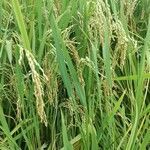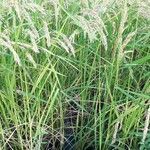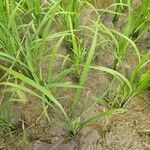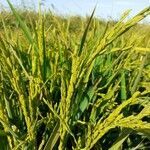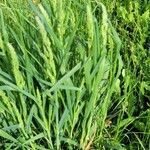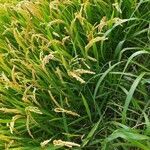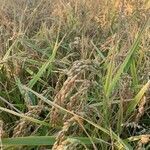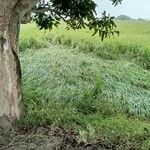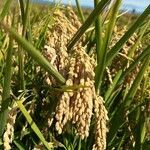Annual, aquatic, tufted. Culms erect, rooting at lower submerged nodes, 0.5–1.5 m tall. Leaf sheaths slightly inflated below, upper sheaths tight, glabrous, auricles falcate, ciliate; leaf blades 25–60 × 0.5–2 cm, glabrous, smooth or scabrid on both sides, margins scabrid, apex acuminate; ligule 10–40 mm. Panicle loosely contracted, up to 30 cm, nodding at maturity; branches 1–3 at lowest node, longest 2–12 cm, axils bearded or glabrous. Spikelets oblong to oblong-lanceolate, 7–10 mm, length 2–3.5 times width, persistent; sterile lemmas lanceolate, 1.5–4 mm, apex acuminate; fertile lemma papillose, spinulose, apex acuminate; awn very variable, slender or stout, up to 60 mm or more, scaberulous, sometimes absent. Anthers 1–3 mm. Caryopsis ovate or elliptic to cylindrical, 5–7 mm, whitish yellow to brown or blackish. 2n = 24.
An annual grass with hollow stems. The stems can be 30 cm to 150 cm tall. (Floating varieties can be 5 m long.) The nodes are solid and swollen. The stem is protected by a skin layer which can often be high in silicon. A clump of shoots are produced as tillers from buds in the lower leaf axils. The leaves are narrow and hairy. They taper towards the tip. Each stem produces 10-20 leaves and the seeds hang from the flower stalk at the top. Some varieties are glutinous and cling together when cooked.
Annual; culms erect, up to 1 m. high or more; sheaths all longer than the internodes, soft, glabrous, auriculate, the auricles sometimes hispid-ciliate; ligule acuminate, mostly 1-2 cm. long; blades 20-40 cm. long, 1-1.5 cm. wide, acu-minate, scabrous; panicles 10-30 cm. long, narrow, dense, becoming top-heavy; spikelets oblong, 7-10 mm. long; glumes narrow, 2-3 mm. long; lemmas hard, ridged by the lateral nerves, more or less hispid, especially on the keel, awnless or awned, the awn variable.
Spikelets 8-11 x 2·5-3·5 mm., not deciduous (the articulation to the pedicel is usually completely solidified but there are, however, some strains in which the spikelets fall off at maturity), obliquely attached to the pedicel, very variable in shape, asymmetrically oblong to elliptic-oblong in lateral view.
Panicle up to 50 cm. long, erect, curved or drooping, very variable in density; rhachis obtusely angular, smooth, glabrous or scattered hairy; branches solitary or clustered, forming a variable angle with the rhachis (from being nearly erect to spreading), angular, scabrous.
Leaf-laminae 12-65 x 0·4 — 1·75 cm., linear, tapering to an acute point, bright green to glaucous, rather flaccid, glabrous or puberulous, rarely scattered with short hairs, smooth on the lower, asperulous on the upper surface; midrib usually distinct.
Annual 1–2 m; blades elongate, 8–15 mm wide; panicle 1–3 dm; lemma 7–10 mm, reticulate rugose, short-pilose, its awn, when present, to 5 cm; 2n=24. Asiatic cultigen, cult. in s. U.S. and occasionally adventive as far n. as se. Va., but not persistent.
Leaf-sheath coarsely striate, tight when young, later somewhat loose, often somewhat spongy, green or sometimes tinged with brown or purple, smooth, glabrous; the lowest usually longer, the upper shorter than the internodes.
Sterile lemmas about equal in shape and size, usually 2-3 mm. long (very rarely up to 1/2 the length of the spikelet in certain forms “winged varieties”), lanceolate, acute, glossy.
Ligule (1·25)1·5-3 cm. long, triangular, acute, entire or split, usually glabrous, sometimes tinged with pink, purple or brown in some varieties or strains.
Fertile lemma as described for O. barthii, sometimes coloured, usually awnless, sometimes awned (the awn often purple-pink, more rarely colourless).
Culms 45-180 cm. tall, 3-many-noded (up to 20), 6-8 mm. in diam., erect or ascending from a geniculate base, terete, hollow, smooth, glabrous.
Glumes (the narrow rim at the base of the spikelet) varying in colour from pale white to yellow, purple or black.
Widely cultivated on river flood-plains in W. Africa, and in a few localities grown as an upland crop.
An annual or rarely short-lived perennial of variable habit.
Sexual organs and caryopsis similar to those of O. barthii.
Pedicels up to 4 mm. long, stout, scabrous.
Paleas as described for O. barthii.
